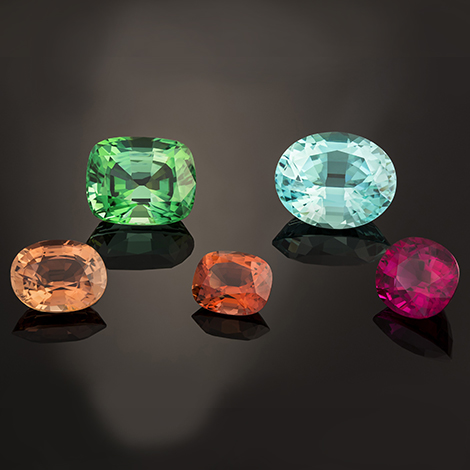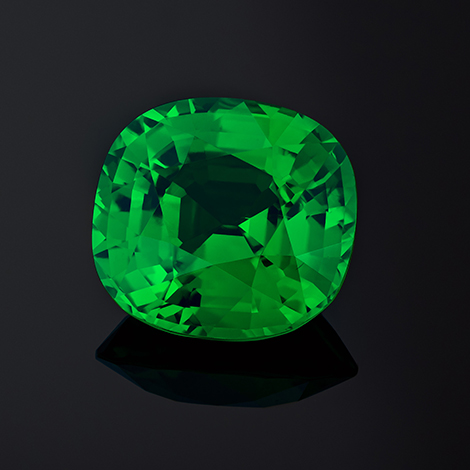The change of shape and/or faceting is an extremely common demand for stone cutter. Each stone has different characteristics (dimensions, number and position of inclusions, faceting, scratch…). Despite all of it, it is possible to establish percentages of loss depending on the change of shape.
For an oval-shaped stone to transform in pear shaped stone, the weight loss represents 27 to 32% depending on the case.
For example, an oval sapphire whose dimensions are 12.99 mm x 10.38 mm x 5.36 mm and weighting 7.05 ct, will give a pear shaped stone of 5.12 ct measuring 12.97 mm x 10 mm x 4.95 mm. This stone perfectly illustrates our average because the loss is 27.38%, which is the low end of our range.
New example with an oval stone measuring 10.67 mm x 7.07 mm x 4.05 mm. After the change of shape, the pear will measure 10.50 mm x 6.90 mm x 3.89 mm. The final dimensions are therefore very close to the initial ones. Despite everything, there is a big fingerprint inclusion in the breech that must disappear looking at the table. The talent of the lapidary will consist in masking it by the reflection of light. The loss of 17.74% preserves the maximum weight from the initial one of 2.65 ct. This small percentage is explained by the general harmony and the absence of scratching. To keep the inclusion in the cylinder head and hiding it by reflecting the light, rather than removing it, contributes to this excellent result.
Another change of form quite common, an oval resized in cushion. The lapidary will loose from 23 to 28% according to the stones and the requests of the customers. Let us illustrate this average with a green grey sapphire of dimensions 9,42 mm x 8,47 mm x 6,24 mm weight 4.49 ct. During trimming, we have to remove the double plates, to harmonize the cylinder head which is slightly off-centered and “robolle” – that it means very convex -, and removed the lack of substance of the girdle to obtain a cushion with harmonious proportions. Measuring 8.20 mm x 7.66 mm x 6.07 mm for a weight after reworking of 3.36 ct, this change in shape resulted in a loss of 25.17%.
Another example of an oval sapphire, whose dimensions are 12.77 mm x 9.88 mm x 5.30 mm and weighs 6.41ct. The problem is different because the recut will be the pretext to remove the fingerprints and the edges raked as well as the double plates, to which is added a striped table. The lapidary will get a cushion shape of 11.98 mm x 9.14 mm x 5.25 mm with a weight of 5.35 ct much purer than originally. The loss is significantly lower as we thought because it represents only 16.54%.
Compared to the previous example, the difference is explained by the “robolle” cylinder head and the lack of substance to the girdle which cause a greater loss on the sapphire.
An oval shaped tsavorite garnet rather long as it measures 8.21 mm x 7.13 mm x 5.40 mm for a weight of 2.85ct must become a square cushion according to the wish of the customer. The initial shape is not ideally suited; the loss is 38.25%, which gives a square cushion of 6.54 mm x 6.51 mm x 4.01 mm for a weight of 1.76ct.
A cushion can be square or rectangular. This harmony of dimensions will influence the loss and according to the initial cut may prove more or less inappropriate if the wish is to hold a dimension.
An average is established for a specific shape change. However, the initial stone and its characteristics are the adjustment variables. It is the experience of gem cutter and its know-how that will make it possible to evaluate this percentage at the most just and thus to value the material.
Sometimes it is necessary to change the faceting while keeping the shape. A loss of 8 to 10% is expected to transform a Brazilian facet cut in a step cut with a grinding wheel much more abrasive than a polished wheel. However, it is possible to reduce this loss to 6% using a softer one, but this option will require 30% more time.
When a recut is necessary, it is essential to study the stone well in order to estimate the loss. It is sometimes best to keep an inclusion by hiding it rather than removing it. Certainly the stone would be close to perfection and pure to the eye but this inclusion is the memory of the millions of years needed for its formation and a unique sign of identification. It is therefore a matter of compromise.


